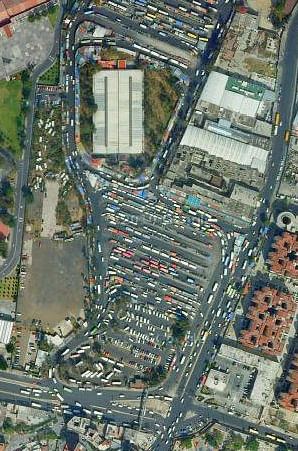
May '13 - Feb '16
Note: Combis, or more accurately, Kombis, refer to small panel microbuses originally made by Volkswagen but have come to refer to a wide variety of makers microbuses. I've traveled in combis in Peru and China, and they seem to satisfy a major trasnportation niche in nearly every developing nation.

Today I hopped a combi and headed into town. As it was early saturday afternoon, there were roadside markets everywhere that had instantaneously set up in the side drive lanes. Our combi driver also let us off at a different part of Quatro Caminos station.
Quatro Caminos, if I haven’t mentioned it before, is much more than a mere metro station. It’s a major transit hub where all the busses and combis from the suburbs and cities beyond the western city limits come in to drop off and pick up passengers. There’s about a dozen bus platforms and each platform has at least two or three route pick ups.
It’s also a serious clusterf*** of traffic engineering. There’s two ways in and out of the station as far as I can tell, and no apparent organization or rules of right of way. The big busses are jammed in with the more nimble combis, and it usually takes ten minutes just to leave the parking lot. The parking lot empties conveniently into a major divided avenue where either there arent any traffic signals or nobody follows them, AND several freeway entrances and exits.

Quatro Caminos is also a major market center. Every platform filled with vendors and stalls selling everything from food to drinks to toys, backpacks, leather goods, shoes, hats, video game arcades, snacks, breads, toiletries, anything and everything can be found here, pushing the pedestrian space of the platforms to 2’ wide strip along the edge of the platform. There are also market pavilions, enclosed strips of markets immediately adjacent to the the station. On top of all the stalls are the vendors with carts or portable tables selling peanuts, churros, bread, and other quick take-aways.
It’s always packed, worse at night. It’s an incredibly vibrant and active labrynth of public spaces with the train platform at the center. People always on the move, lining up for tickets, lining up to get into the station, eating, begging, selling, hanging out, playing games, socializing. Never a dull moment. It’s such a warren I still can’t figure it out even with the aid of Google maps. There’s such a minute grain to it that an aerial photo can’t capture.
So when I got off the bus, I was lost. Even though I was at the metro, I had no clue where I was or where to go. People were generally going two directions. One lead me to the street which was wrong, and the other flow crossed several platforms, threaded its way through several covered market pavilions before finally diving into the Metro station itself.
That’s one major complaint. The metros can be so thickly surrounded by stalls and hawkers you could walk right be and miss the entrance.
Urban and architectural explorations from Mexico City to Stuttgart Germany through the eyes of a iterant architectural designer
No Comments
Block this user
Are you sure you want to block this user and hide all related comments throughout the site?
Archinect
This is your first comment on Archinect. Your comment will be visible once approved.